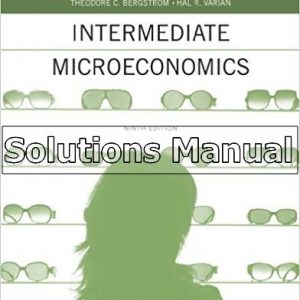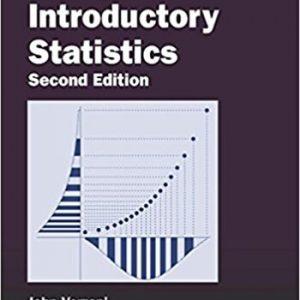This is completed downloadable of Solution Manual for Accounting Information Systems, 10th Edition

Product Details:
- ISBN-10 : 113393594X
- ISBN-13 : 978-1133935940
- Author: Ulric J. Gelinas, Richard B. Dull, Patrick Wheeler
Users explore today’s most intriguing AIS topics to see how they relate to business processes, information technology, strategic management, security, and internal controls. The text is clearly written to help users grasp even the most challenging topics. ACCOUNTING INFORMATION SYSTEMS, 10E focuses on three critical accounting information systems used today: enterprise systems, e-Business systems, and controls for maintaining those systems. The tenth edition provides users with the necessary tools and processes for organizing and managing information.
Table of Content:
- Brief Contents
- Contents
- Preface
- Acknowledgments
- Part I: Overview of Accounting Information Systems
- Chapter 1: The Information System: An Accountant’s Perspective
- The Information Environment
- Organizational Structure and AIS
- The Role of Accountants in AIS
- Summary
- Key Terms
- Review Questions
- Discussion Questions
- Multiple-Choice Questions
- Problems
- Chapter 2: Introduction to Transaction Processing
- An Overview of Transaction Processing
- Accounting Records
- File Structures
- Documentation Techniques
- Transaction Processing Models
- Data Coding Schemes
- Summary
- Appendix: Data Structures
- Key Terms
- Review Questions
- Discussion Questions
- Multiple-Choice Questions
- Problems
- Chapter 3: Ethics, Fraud, and Internal Control
- Ethical Issues in Business
- Fraud and Accountants
- Internal Control Concepts and Techniques
- Summary
- Key Terms
- Review Questions
- Discussion Questions
- Multiple-Choice Questions
- Problems
- Part II: Transaction Cycles and Business Processes
- Chapter 4: The Revenue Cycle
- The Conceptual System
- Physical Systems
- Summary
- Appendix: Sales Return System
- Key Terms
- Review Questions
- Discussion Questions
- Multiple-Choice Questions
- Problems
- Internal Control Cases
- Chapter 5: The Expenditure Cycle Part I: Purchases and Cash Disbursements Procedures
- The Conceptual System
- Physical Systems
- Summary
- Key Terms
- Review Questions
- Discussion Questions
- Multiple-Choice Questions
- Problems
- Internal Control Cases
- Chapter 6: The Expenditure Cycle Part II: Payroll Processing and Fixed Asset Procedures
- The Conceptual Payroll System
- The Physical Payroll System
- The Conceptual Fixed Asset System
- Summary
- Key Terms
- Review Questions
- Discussion Questions
- Multiple-Choice Questions
- Problems
- Internal Control Cases
- Chapter 7: The Conversion Cycle
- The Traditional Manufacturing Environment
- World-Class Companies and Lean Manufacturing
- Techniques and Technologies That Promote Lean Manufacturing
- Accounting in a Lean Manufacturing Environment
- Information Systems That Support Lean Manufacturing
- Summary
- Key Terms
- Review Questions
- Discussion Questions
- Multiple-Choice Questions
- Problems
- Internal Control Cases
- Chapter 8: Financial Reporting and Management Reporting Systems
- The General Ledger System
- XBRL-Reengineering Financial Reporting
- Controlling the GL/FRS
- The Management Reporting System
- Data Analytics and Ad Hoc Reporting
- Summary
- Key Terms
- Review Questions
- Discussion Questions
- Multiple-Choice Questions
- Problems
- Part III: Advanced Technologies in Accounting Information
- Chapter 9: Database Management Systems
- Overview of the Flat-File versus Database Approach
- Elements of the Database Environment
- The Relational Database Model
- Top-Down Approach to Designing Relational Databases
- Databases in a Distributed Environment
- Summary
- Appendix: Distinguishing Features of Structured Databases
- Key Terms
- Review Questions
- Discussion Questions
- Multiple-Choice Questions
- Problems
- Chapter 10: The REA Approach to Database Modeling
- The REA Approach
- Developing an REA Model
- View Integration: Creating an Enterprise-Wide REA Model
- Summary
- Key Terms
- Review Questions
- Discussion Questions
- Multiple-Choice Questions
- Problems
- Chapter 11: Enterprise Resource Planning Systems
- What Is an ERP?
- ERP System Configurations
- Data Warehousing
- Risks Associated with ERP Implementation
- Implications for Internal Control and Auditing
- Summary
- Key Terms
- Review Questions
- Discussion Questions
- Multiple-Choice Questions
- Problems
- Chapter 12: Electronic Commerce Systems
- Intra-Organizational Networks and EDI
- Internet Commerce
- Risks Associated with Electronic Commerce
- Security, Assurance, and Trust
- Implications for the Accounting Profession
- Summary
- Appendix: Intra-Organizational Electronic Commerce
- Key Terms
- Review Questions
- Discussion Questions
- Multiple-Choice Questions
- Problems
- Part IV: Systems Development Activities
- Chapter 13: Systems Development and Program Change Activities
- The Systems Development Process
- Participants in Systems Development
- Information Systems Acquisition
- The Systems Development Life Cycle
- The Role of Accountants
- Summary
- Key Terms
- Review Questions
- Discussion Questions
- Multiple-Choice Questions
- Problems
- Part V: Computer Controls and IT Auditing
- Chapter 14: Auditing IT Controls Part I: Sarbanes-Oxley and IT Governance
- Overview of Auditing
- Financial Audit Components
- Structure of an Audit
- Overview of SOX Sections 302 and 404
- IT Governance Controls
- Organizational Structure Controls
- Computer Center Security and Controls
- Disaster Recovery Planning
- Outsourcing the IT Function
- Summary
- Key Terms
- Review Questions
- Discussion Questions
- Multiple-Choice Questions
- Problems
- Chapter 15: Auditing IT Controls Part II: Security and Access
- Controlling the Operating System
- Controlling Database Management Systems
- Controlling Networks
- Electronic Data Interchange Controls
- Summary
- Appendix: Malicious and Destructive Programs
- Key Terms
- Review Questions
- Discussion Questions
- Multiple-Choice Questions
- Problems
- Chapter 16: Auditing IT Controls Part III: Systems Development, Program Changes, and Application Aud
- Systems Development Controls
- IT Application Control Testing and Substantive Testing
- Internal Control Testing Techniques
- Substantive Testing Techniques
- Summary
- Key Terms
- Review Questions
- Discussion Questions
- Multiple-Choice Questions
- Problems
- Glossary
- Index
People Also Search:
accounting information systems 10th edition
financial accounting information for decisions 10th edition connect





